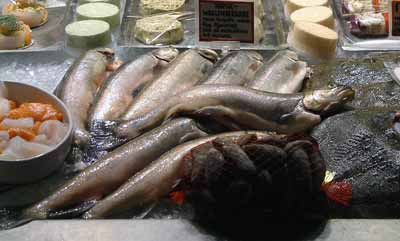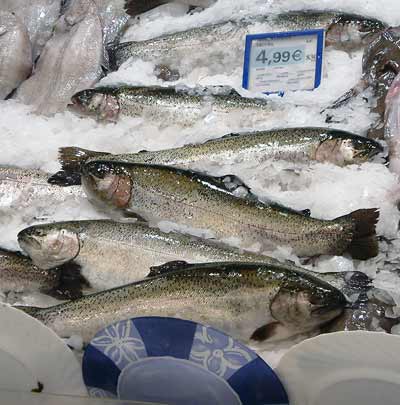"Trumpet of the dead." Black chanterelle or horn of plenty. A wild mushroom which should be cooked.
A cone of semihard cheese traditionally made with goat and sheep's milk but now more likely to be made with a mixture of cow and goat's milk. It has a mild, springy, very pale paste with a few small holes and a glossy rind the colour of butter. This cheese contains 45% fat (dry). The curds are scalded and pressed. It is available made with vegetarian rennet in which form it is suitable for vegetarians. It may be found weighing 600 g - 1.5 kg (1.¼-3 lb). Affinage is usually 1 week. The cone has a deep indentation in the top.

Char(r) usually refers to the Arctic char, an uncommon freshwater fish of the same family as salmon, trout and related to grayling and the vendace or powan. It is found in rivers and lakes of northern Europe, north western United States and Canada and in the Great Lakes. They are migratory fish, like salmon and trout. They have a steely blue-grey back with salmon-pink speckles on the sides and a red underbelly. They have sweet firm flesh which varies from white to pink, dependent upon its own diet, and with good flavour, some say better than trout, being something like a cross between trout and salmon.

Char(r) usually refers to the Arctic char, an uncommon freshwater fish of the same family as salmon, trout and related to grayling and the vendace or powan. It is found in rivers and lakes of northern Europe, north western United States and Canada and in the Great Lakes. They are migratory fish, like salmon and trout. They have a steely blue-grey back with salmon-pink speckles on the sides and a red underbelly. They have sweet firm flesh which varies from white to pink, dependent upon its own diet, and with good flavour, some say better than trout, being something like a cross between trout and salmon.

Trout caught in a river. Commonly this is the brown trout.
Lake trout. A freshwater char living mainly in lakes in northern North America. As in Europe, this char is not a common fish. Lake trout were fished commercially in the Great Lakes until lampreys, overharvest and pollution severely reduced the stocks. Commercial fisheries still exist in some areas of the Great Lakes and smaller lakes in northern Canada.